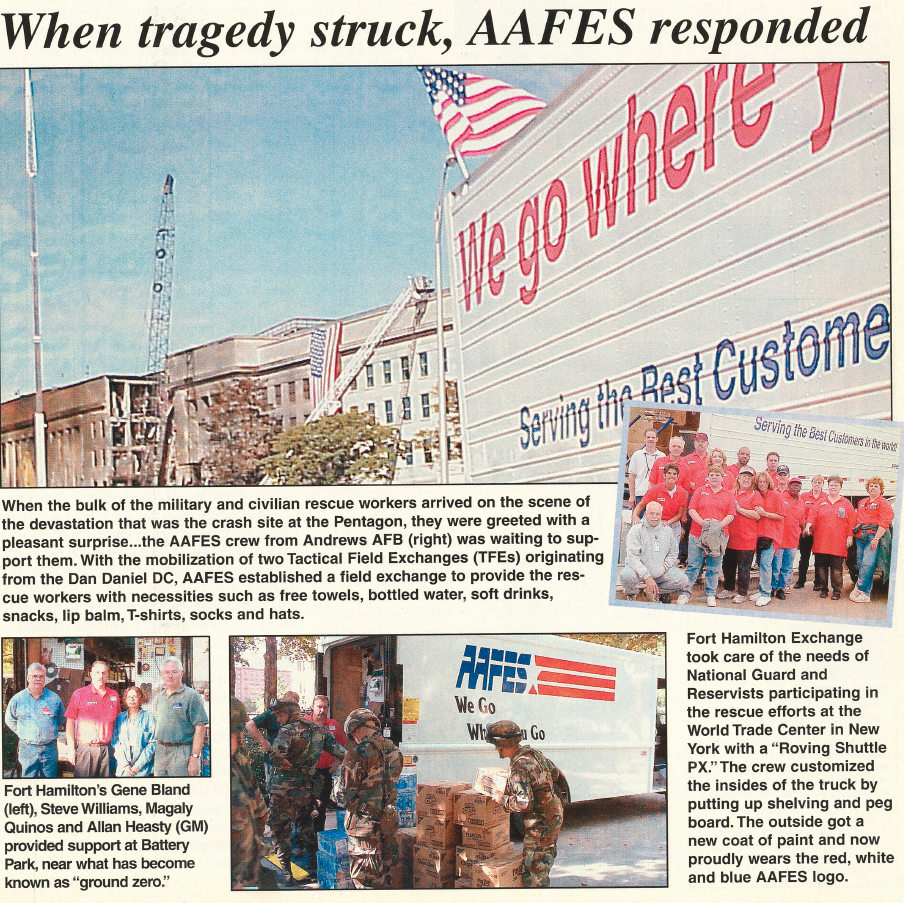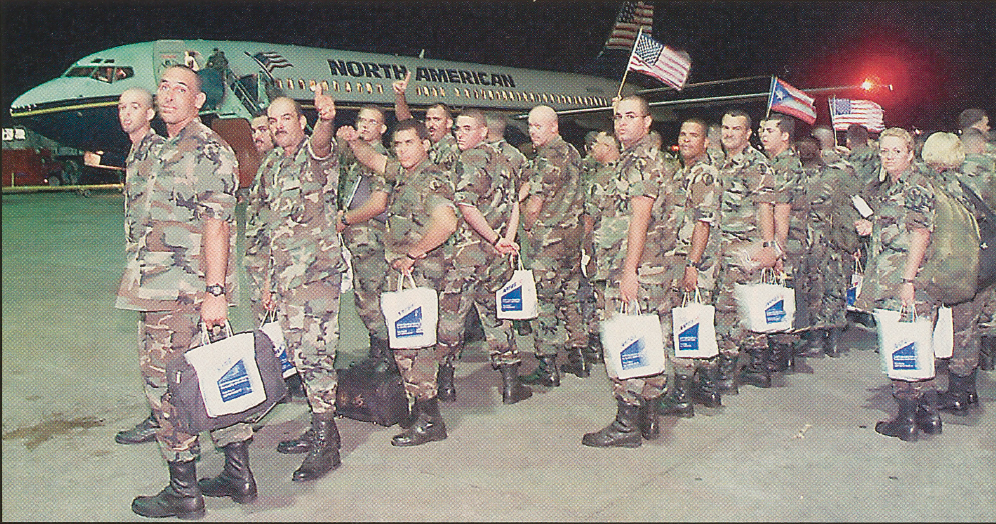#FlashbackFriday: The Exchange Responds After the 9/11 Attacks

Wednesday will be the 23rd anniversary of the 9/11 terrorist attacks on the World Trade Center towers and the Pentagon, as well as the heroic sacrifice of the United 93 passengers who prevented an attack on the U.S. Capitol. Nearly 3,000 people died in the attacks.
Below is a photo page from the October 2001 Exchange Post, showing some of the Exchange’s support in New York and Washington after the attacks.

Steve Williams, seen in the lower left photo, was manager of Brooklyn’s Fort Hamilton Exchange. He had just started a meeting to discuss a store renovation when his assistant told him that a plane had struck the World Trade Center. The next day, Williams, Area Manager Ray Black and then-West Point General Manager Allan Heasty (also pictured) started preparing for the arrival of a mobile field Exchange, which was in Battery Park at the southern end of Manhattan by Sept. 13 to support National Guard troops.
Bob Ellis, then the head of the Exchange’s Washington office, had stepped out of a meeting at the Pentagon seven minutes before American Airlines Flight 77 slammed into the building, hitting the room that he had been in. Beth Goodman-Bluhm, then manager at Andrews AFB. worked with Ellis to help set up a mobile field Exchange outside the Pentagon, staffed 24/7 by associates to support rescue workers. (Goodman-Bluhm retired from the Exchange in December 2022 as a vice president in Central Region but continues with the organization as regional vice president for Southwest Asia.)
Exchange associates from outside the New York or Washington areas also contributed. One of them was Leslie Munsey (pictured below), a stationery buyer for the Exchange, who helped fulfill an urgent need for American flags to honor some of the fallen heroes of 9/11.

After the 9/11 tragedy, the city of New York was faced with burying hundreds of firefighters, police officers, emergency medical service providers and other heroes. The city had exhausted its conventional means of acquiring American flags for burial services and turned to the Exchange for help. The city needed 600 flags.
Munsey responded quickly by contacting her normal supplier. When the supplier had no available flags, she contacted another supplier, Valley Forge, which suggested that Munsey go to the Veterans Administration for assistance.
“The VA agreed to allow us to ‘borrow’ the flags and replenish their supply when we could,” Munsey told the Exchange Post. “When the VA learned why we needed the flags, they dropped their normal red tape and finalized the agreement in just two hours from the time I called them.”
The flags were shipped to New York overnight and arrived the next day, in time for several funerals.
“The people who maintain the ‘stockpile, shipped the flags Fed Ex overnight and covered the freight,” Munsey said. “Valley Forge not only reduced AAFES’ cost, but worked diligently to pay back the 600 flags within four weeks.”
Munsey retired from the Exchange in 2005 after more than 20 years of service.
Other examples of Exchange support after 9/11:
- More than 2,500 Exchange associates signed a 24-by-4-foot banner with the inscription “United We Stand,” which in October 2001 was presented to the administrative assistant of the Secretary of the Army to be displayed at the Pentagon.
- Truck drivers Brian Hartley and Scott Moore, who transported donated goods from the Dan Daniel Distribution Center to New York, stuck around to help set up a mobile field Exchange, then spent the day assisting customers and helping run the register.
- At Fort Eustis in southeastern Virginia and Fort Dix and McGuire Air Force Base in New Jersey, associates held bake sales to raise money for a Red Cross emergency relief fund.
- During its Toyland opening on Sept. 15, 2001, the Whiteman Air Force Base Exchange in Missouri held a “We Love NYC” campaign to collect money for victims of the World Trade Center attacks.
- Associates at Travis Air Force Base in California delivered breakfast and lunch to troops who were manning the gates, ensuring the safety of the installation in the days after attack.
- Associates at Fort Campbell, Kentucky, delivered doughnuts to weary Soldiers protecting the post.
- Kim Bezotte, a Redstone Arsenal associate, put her cooking talent to use: In two days, she prepared 360 egg rolls to raise money for victims of the attacks. Sales raised $210 for the Red Cross NY Rescue 911 fund.
- In Hawaii, Schofield Barracks conducted Operation Aloha Lei, assembling a memorial lei more than two football fields long with floral messages honoring attack victims.
- In Heidelberg, Germany, the associate who ran the airfield snack bar stayed open on Sept. 12, when most facilities were closed, to singlehandedly support troops. Airfield command center sent a letter to the European Stars and Stripes thanking her for her service.
Sometimes the Exchange received support: In Germany, three days after the attacks, students from Gruenstadt Secondary School, Leininger Gymnasium, presented the interim general manager of the Gruenstadt Depot Exchange with a condolence list, as well as about DM 4,600 (about $2,400 in U.S. dollars at the time) they had collected, which was given to the local Red Cross chapter.

In Puerto Rico after 9/11, the Exchange provided support for more than 100 Puerto Rican Army National Reservists who flew to Washington to assist with cleanup efforts at the Pentagon.




Great article and reminder ! We will never forget ! “Together We continue To Be Stronger ” !
Thank you for sharing “The Exchange” piece of history around this valiant ‘Team Response and Effort” !